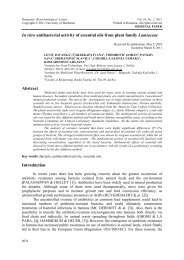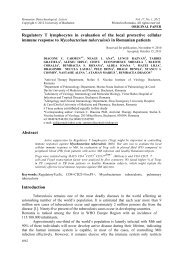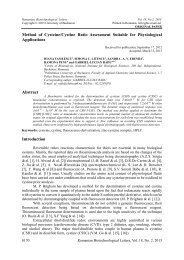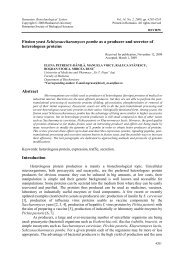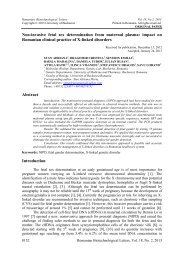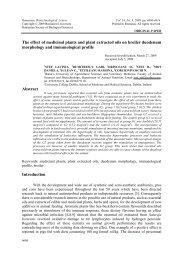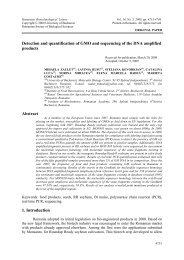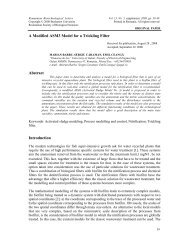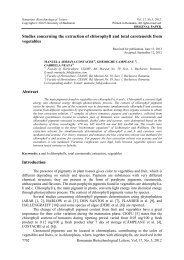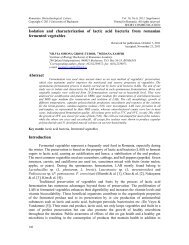The use of RAPD and ISSR markers for genetic ... - Rombio.eu
The use of RAPD and ISSR markers for genetic ... - Rombio.eu
The use of RAPD and ISSR markers for genetic ... - Rombio.eu
Create successful ePaper yourself
Turn your PDF publications into a flip-book with our unique Google optimized e-Paper software.
VELICEVICI GIANCARLA, MADOŞĂ EMILIAN, ŞUMĂLAN RADU,<br />
CIULCA SORIN,POPESCU SORINA, PETOLESCU CERASELA<br />
At the same time were identified 5 alleles presented to all the 19 th genotypes studied<br />
(Table.8). Those alleles could be considered specific <strong>markers</strong> <strong>for</strong> the barley.<br />
Table 8. Specific alleles common <strong>for</strong> all the barley genotypes studied<br />
No. Specific alleles<br />
1 HB14-1000pb<br />
2. HB14-450pb<br />
3. 810-950pb<br />
4. 810-1100pb<br />
5. 810-1300pb<br />
<strong>The</strong> analysis results made through two categories <strong>of</strong> primers had emphasized the fact that to<br />
some cultivar studied it were identified unique b<strong>and</strong>s (Table.9). Those b<strong>and</strong>s could be <strong>use</strong>d as<br />
potential DNA <strong>markers</strong> to identify the barley genotypes.<br />
Table 9. Specific alleles <strong>for</strong> certain barley genotypes<br />
No. Genotype Specific alleles<br />
1. Lyric HB15-150pb<br />
2. Secura 811-1000pb<br />
3. Dina 811-1500pb<br />
4. Compact HB14- 200pb<br />
5 Precoce OPA-05-450pb<br />
Molecular characterization revealed 91,17% polymorphism <strong>of</strong> <strong>RAPD</strong> <strong>markers</strong> <strong>and</strong><br />
89.13% polymorphism <strong>of</strong> <strong>ISSR</strong> <strong>markers</strong> among cultivars. <strong>The</strong> difference is perhaps explained<br />
by the difference in the DNA segments targeted by the two methods. <strong>The</strong> similar results were<br />
observed by [10,13, 26]. Markers <strong>ISSR</strong> proved more efficient than <strong>RAPD</strong> <strong>markers</strong> thanks to<br />
the higher number <strong>of</strong> b<strong>and</strong>s/primer (9,2) <strong>and</strong> <strong>of</strong> efficiency index (8,2). Fern<strong>and</strong>ez et al. (2002)<br />
have studied 16 barley cultivars <strong>for</strong>m different countries <strong>and</strong> they have found high similarity<br />
index by <strong>ISSR</strong>s than by <strong>RAPD</strong>s. It may be due to highly polymorphic, abundant nature <strong>of</strong> the<br />
microsattelites due to slippage in DNA replication.<br />
<strong>The</strong> variation amplitude about the sizes b<strong>and</strong>s was significant superior in case <strong>of</strong> <strong>ISSR</strong><br />
primers (4950pb), comparative with <strong>RAPD</strong> primers (3425pb). <strong>The</strong> differences found among<br />
the dendrograms generated by <strong>RAPD</strong>s <strong>and</strong> <strong>ISSR</strong>s could be partially explained by the different<br />
number <strong>of</strong> PCR products analyzed (68 <strong>for</strong> <strong>RAPD</strong>s <strong>and</strong> 46 <strong>for</strong> <strong>ISSR</strong>s) rein<strong>for</strong>cing again the<br />
importance <strong>of</strong> the number <strong>of</strong> loci <strong>and</strong> their coverage <strong>of</strong> the overall genome, in obtaining<br />
reliable estimates <strong>of</strong> <strong>genetic</strong> relationships among barley cultivars. Similar results had been<br />
observed by [10] also in barley.<br />
<strong>The</strong> microsatellites or intersimple sequence repeat (<strong>ISSR</strong>) <strong>markers</strong> <strong>and</strong> r<strong>and</strong>omly amplified<br />
polymorphic DNA (<strong>RAPD</strong>) <strong>markers</strong> have proved to be the most polymorphic <strong>markers</strong> in<br />
barley <strong>and</strong> hence are highly <strong>use</strong>ful <strong>markers</strong> <strong>for</strong> various applications in barley [10 ]. <strong>The</strong>se<br />
<strong>markers</strong> can be <strong>use</strong>d <strong>for</strong> selection <strong>of</strong> important agronomic traits which would increase the<br />
efficiency <strong>and</strong> precision <strong>of</strong> breeding. In a previous study [12], some traits were <strong>use</strong>d to<br />
evaluate the agronomical potentiality <strong>of</strong> barely specimens in south Tunisia. It has been noted<br />
that although the importance <strong>of</strong> agronomic parameters, it is necessary to <strong>use</strong> other <strong>markers</strong> to<br />
study diversity <strong>and</strong> select genotypes with high potential.<br />
With that study we could conclude that the bulk analyses <strong>of</strong> <strong>RAPD</strong> <strong>and</strong> <strong>ISSR</strong> <strong>markers</strong><br />
were <strong>use</strong>ful <strong>for</strong> study the <strong>genetic</strong> relationships between barley cultivars, providing the <strong>ISSR</strong><br />
7500 Romanian Biotechnological Letters, Vol. 17, No. 4, 2012



